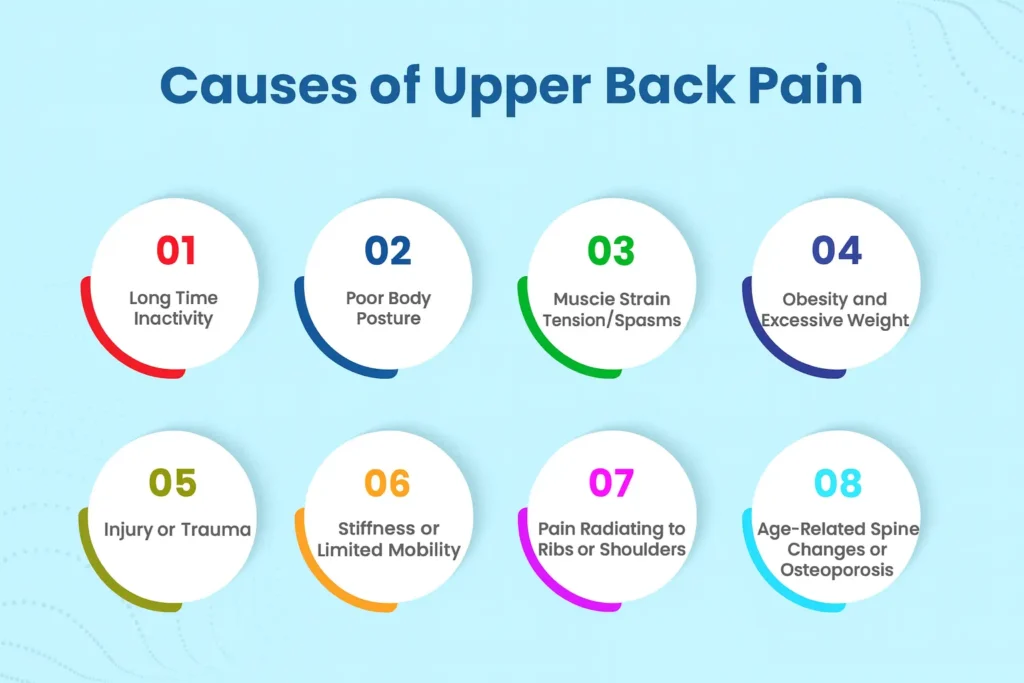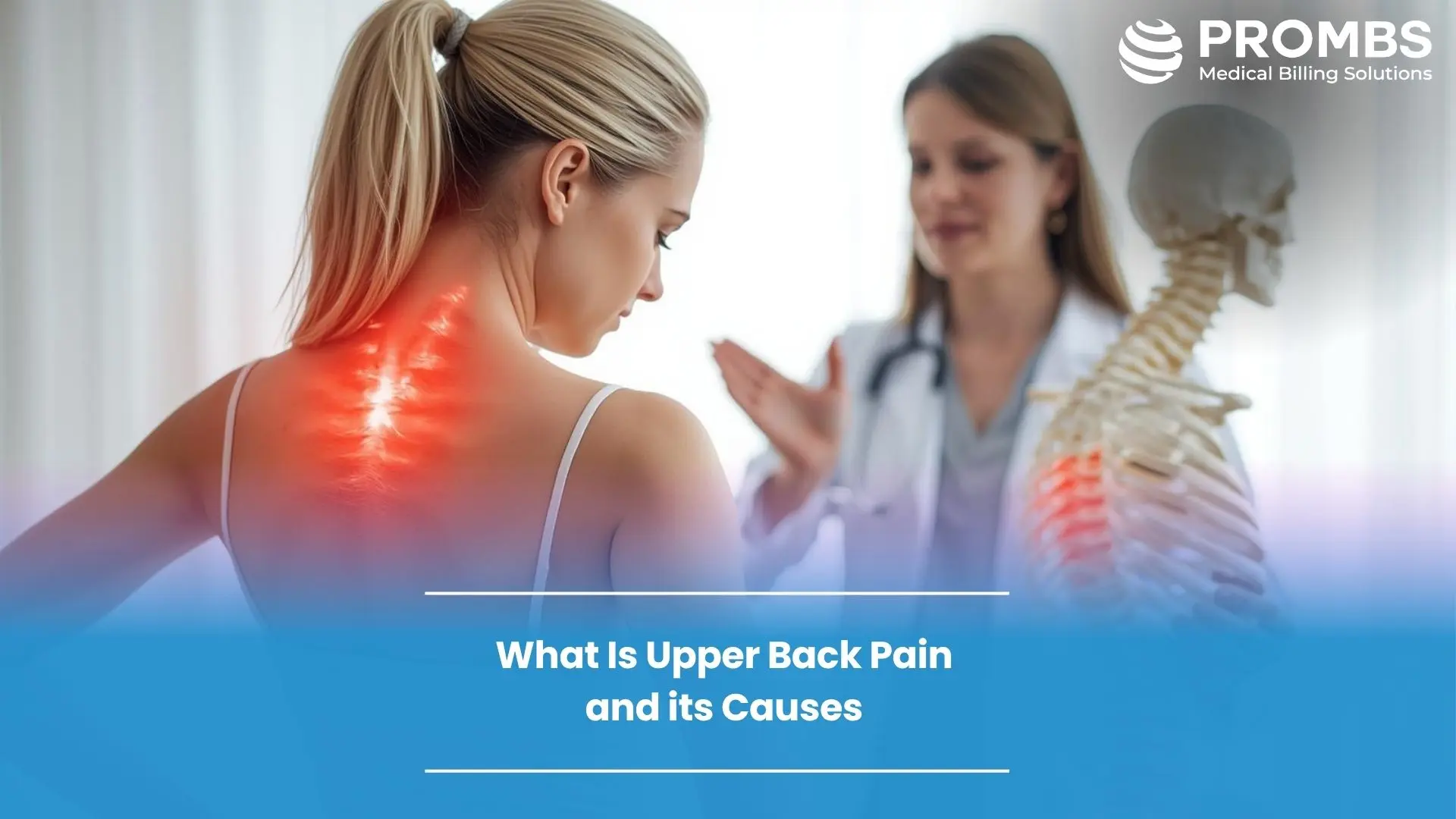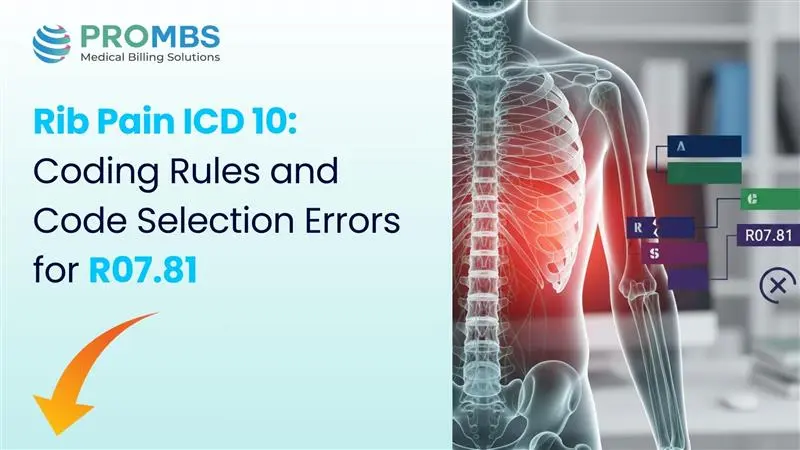Accurate ICD-10 coding is the backbone of clean claim submission and timely reimbursement. For conditions like upper back pain, choosing the correct code is more than a routine task; it determines how medical necessity is validated, how payers approve claims, and how smoothly revenue flows.
Upper back pain is a frequent reason for outpatient visits, yet it is often miscoded due to incomplete documentation or lack of specificity. Proper coding not only reduces claim denials but also strengthens compliance and audit readiness. According to the CMS ICD-10-CM Official Guidelines for Coding and Reporting, precise code selection is critical for demonstrating medical necessity and ensuring consistent reimbursement.
This blog offers a clear, step-by-step guide to using ICD-10 code M54.9 for upper back pain, helping providers improve billing accuracy, meet payer requirements, and maintain a healthier revenue cycle.
What Is Upper Back Pain and its Causes
Upper back pain refers to discomfort in the thoracic spine (T1–T12), often caused by muscle strain, posture problems, or age-related spine changes. When no specific underlying disorder is identified, it is coded as unspecified dorsalgia under M54.9.
Patients typically report persistent or recurrent pain in the thoracic region, sometimes accompanied by stiffness or limited mobility. These signs indicate clinically significant upper back pain that requires evaluation.
In some cases, the pain radiates to the ribs or shoulders without a clear structural cause. Documenting these symptoms accurately supports the use of M54.9 and helps establish medical necessity for payer compliance.

ICD-10 Code M54.9 for Upper Back Pain
The ICD-10 code for upper back pain is M54.9, classified as dorsalgia, unspecified under the Centers for Medicare & Medicaid Services Guidelines. It is used when pain in the upper or mid-back is clinically confirmed but not linked to a specific underlying disorder such as a disc herniation, fracture, or scoliosis.
According to the Centers for Medicare & Medicaid Services (CMS), accurate use of ICD-10 codes is essential for demonstrating medical necessity, which directly impacts claim approval and reimbursement. Proper application of M54.9 requires detailed documentation that captures symptom onset, clinical findings, and any related conditions, ensuring compliance with payer policies and reducing the risk of denials.
Why Is the ICD-10 Code for Upper Back Pain Important for Billing?
The ICD-10 code for upper back pain (M54.9) is not just a diagnostic label; it drives payer evaluation of medical necessity for visits, imaging, and therapeutic interventions, as emphasized in the CMS ICD-10-CM Official Guidelines for Coding and Reporting.
Incorrect coding or lack of supporting documentation can lead to:
- Claim denials and delayed payments
- Increased audit risk
- Revenue loss and workflow disruptions
Accurate application of M54.9, supported by clinical documentation, improves first-pass acceptance and protects revenue cycle performance.
When should the ICD-10 Code for Upper Back Pain (M54.9) Be Used?
Use M54.9 as the primary diagnosis when the patient’s chief complaint is upper back pain and no more specific condition (for example, disc herniation or fracture) is identified.
Do not use M54.9 when:
- The pain is secondary to another primary condition (for example, scoliosis, vertebral fracture, infection) - code that condition first.
- The documentation is vague or lacks clinical confirmation.
Correct sequencing ensures payer compliance and accurate reimbursement.
Related ICD-10 Codes for Upper Back Pain
Related ICD-10 Codes for Upper Back Pain include the specific diagnosis codes used to document the underlying cause of upper back pain, ensuring accurate coding, proper treatment planning, and smooth claim processing.
| ICD-10 Code | Description |
|---|---|
| M54.6 | Pain in thoracic spine (more specific than M54.9) |
| M54.5 | Low back pain |
| M54.2 | Cervicalgia (neck pain) |
| R07.89 | Other chest pain (if pain is localized but not musculoskeletal) |
| G54.0 | Brachial plexus disorders (if pain is neuropathic in origin) |
Linking secondary or related diagnoses appropriately with M54.9 strengthens claims and minimizes payer disputes.
CPT Codes Paired With ICD-10 Code for Upper Back Pain
CPT Codes Paired With ICD-10 Code for Upper Back Pain (M54.9) refer to the procedure codes commonly linked with this diagnosis, such as evaluation, imaging, or therapeutic services, to ensure accurate billing and timely reimbursement.
| CPT Code | Description |
|---|---|
| 99213 / 99214 | Established patient office or outpatient visits (low–moderate complexity) |
| 97110 | Therapeutic exercises for back pain management |
| 97140 | Manual therapy techniques |
| 97012 | Mechanical traction (if prescribed) |
| 72146 | MRI of thoracic spine (if imaging is performed) |
Correctly pairing M54.9 with these CPT codes demonstrates medical necessity for services rendered.
What Causes Claim Denials for ICD-10 Code?
Claim denials for ICD-10 code M54.9 often arise from incomplete documentation, misuse of the unspecified code, or discrepancies between diagnosis and billed CPT procedures.
Understanding these common pitfalls is essential for maintaining compliance, ensuring medical necessity, and protecting reimbursement, as highlighted in the CMS Medicare Claims Processing Manual.
Common denial triggers include:
- Using unspecified code M54.9 when a more specific diagnosis is documented (for example, M54.6 for thoracic spine pain)
- Lack of clinical documentation supporting the diagnosis
- Mismatch between ICD-10 code and CPT-billed services (for example, billing for MRI without documented medical necessity)
- Missing procedure-specific details such as start/stop times for therapy or site of pain
These errors delay reimbursement, increase administrative workload, and elevate audit risk.
How Can Providers Avoid Denials When Using ICD-10 Code M54.9?
Avoiding denials begins with precise documentation. Providers should establish upper back pain as the primary diagnosis only when it is clinically confirmed and clearly identified as the main reason for the visit. Supporting details such as onset, severity, and physical exam findings should be thoroughly documented alongside any secondary conditions like scoliosis or muscle strain. Procedure-related specifics, including laterality, therapy start and stop times, and justification for imaging, must be consistently recorded to demonstrate medical necessity and support the services billed.
Equally crucial is aligning each claim with payer-specific medical necessity criteria to prevent coding mismatches. Routine pre-submission audits can flag gaps in documentation or discrepancies between diagnosis and CPT codes before the claim is sent. This proactive, compliance-focused workflow not only minimizes denials and delays but also improves first-pass acceptance rates, helping practices maintain a steady and predictable revenue cycle.
Documentation Supporting ICD-10 Code M54.9
Provider documentation should include:
- Clinical confirmation of upper back pain, including onset, severity, and progression
- Physical exam findings such as tenderness, range of motion, or neurological deficits
- Imaging results or lab reports (if applicable) that influence the treatment plan
- Notations about related conditions (for example, muscle strain, degenerative disc disease)
- Details of therapeutic interventions, including start/stop times and response to treatment
Comprehensive documentation ensures claims withstand payer review and audit scrutiny.
How Does Pro-MBS Optimize Billing for ICD-10 Code M54.9?
We specialize in applying the ICD-10 code for upper back pain (M54.9) with strict accuracy and linking it to the correct CPT codes such as 97110 and 97140.Our billing and coding experts validate all required details, including proper sequencing with secondary diagnoses, payer-specific policy alignment, and procedure-specific documentation.
This precision eliminates coding ambiguities, minimizes denials, and ensures claims clearly demonstrate medical necessity.
By leveraging advanced billing protocols, compliant workflows, and denial-prevention strategies, Pro-MBS streamlines claim submission across outpatient, therapy, and imaging care settings.
We focus on compliance, documentation integrity, and real-time error resolution, enabling providers to achieve higher first-pass acceptance rates, optimized revenue cycle performance, and stronger financial outcomes.
FAQs
What is the ICD-10- CM code for upper back pain, unspecified?
The ICD-10-CM code M54.9 (Dorsalgia unspecified) is used to report upper back pain when neither the spinal region nor the underlying cause is specified. It is applied when documentation does not provide enough detail to assign a more specific code such as M54.6 for thoracic spine pain.
What is the ICD-10-CM code for upper back pain between the shoulder blades?
The ICD-10-CM code for upper back pain between the shoulder blades is M54.6 (Pain in thoracic spine). It is used when the pain is localized to the thoracic region without specifying an underlying cause.
What are the symptoms of upper back pain?
Typical symptoms of upper back pain include thoracic spine discomfort, paraspinal muscle tenderness, and limited spinal mobility. It may also radiate between the shoulder blades or worsen with postural stress or deep breathing.
What is the ICD code for upper and lower back pain?
The ICD-10-CM code for upper back pain is M54.6 (Pain in thoracic spine), while lower back pain is coded as M54.5 (Low back pain). These codes specify the pain location for accurate clinical documentation, medical necessity justification, and reimbursement compliance.
What is the ICD-10 code for Myalgia upper back?
The ICD-10-CM code for myalgia (muscle pain) in the upper back is M79.1 (Myalgia). It is used to report pain localized to the muscles, including those in the thoracic and upper back regions, for proper clinical documentation and payer reimbursement.
What is the diagnosis of upper back pain?
The diagnosis of upper back pain is typically documented as Pain in Thoracic Spine (ICD-10-CM: M54.6). Clinically, it refers to pain originating from the muscles, ligaments, vertebrae, or discs in the thoracic region of the spine, often associated with conditions such as myofascial strain, poor posture, or underlying spinal disorders.



